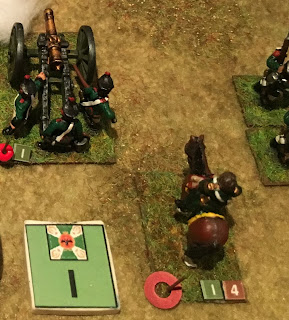Written Orders
In the quest for simple, easy to use and fast playing rules, I've avoided written orders. I also mainly play solo and written rules feel like they are unnecessary. However, after many solo games with my rules I think that there is a case to be made for written orders. The pre-planning that appeared to be an important aspect of most battles is missing, and there is a temptation to instantly respond to changing battlefield situations as if each commander had omniscient knowledge of the battlefield positions.
The other trigger for considering written orders came when I started to look at how to incorporate a programmed opponent when playing solo. It became apparent that an AI system would work much better with an overall battle plan.
A typical army commander would set orders at the start of a battle for each division or brigade under his command. Changes in orders could be made but the fog of war and the vagaries of delivering and interpretting orders could often result in unintended outcomes. This can be found in many accounts of Napoleonic battles.
So, I've bitten the bullet, and put together a high level order system to limit the god-like power I wield when playing solo. Taking advantage of this inclusion, I have also bolted on an AI system to manage the overall battle plan for one side in a battle. The tactical implementation of this battle plan would be something I would continue to do for both sides.
Command Orders
All commands are now allocated command orders:
Attack - Must move all units (infantry and cavalry) into contact with the target. Cavalry must counter-charge enemy cavalry.
Supported Attack - Must move up to half the units (infantry and cavalry) into contact with the target. Any attacking units that are routed can be replaced in the attack by a supporting unit. Cavalry must counter-charge enemy cavalry.
Advance - Must move all units (infantry and cavalry) to within 1 move of the target. Artillery move within effective range (>=2 battle die). Cavalry must counter-charge enemy cavalry. Infantry cannot initiate melee.
Partial Advance - Must move up to half the units (infantry and cavalry) to within 1 move of the target. Cavalry must counter-charge enemy cavalry. Infantry cannot initiate melee.
Move - All units must move to the target position. No combat is allowed unless counter-charging. Once at target position, orders automatically revert to Defend target.
Defend - Units can only initiate melee to regain position. Units cannot move away from the defensive position. Cavalry may counter-charge enemy cavalry.
Retire - All units must retire to target or until out of shooting or charge range.
Support - All units must move to be within 3 hexes of the rear of the target. If target retires on support then orders revert to Defend current position.
Partial Support - Up to half the units (infantry and cavalry) units must move to be within 3 hexes of the rear of the target. If target retires on support then orders revert to Defend current position.
Reserve - Units must remain in position and cannot battle. If the enemy moves to within 5 hexes or fires on any units then orders revert to Defend current position. A command can change orders to any order type without needing a change of orders test. Reserve order can only be set at the start of a game.
Change of Orders Test
A change of orders is successful if a d6 roll is greater than or equal to 4. Add any bonus/penalty CPs to the die roll for the current command.
Commands on Reserve orders can change orders without testing.
Some orders automatically revert to a default Defend order once a target has been reached.
If an order change is successful then erase old orders and add new.
Game Implementation
The next challenge was to work out a game mechanism that is relatively elegant and minimises bits of paper or rosters of orders. The solution came by replacing the existing command chits, used to select the next active command, with dry-erasable cards. The command chits were simple scrabble tiles with letters on them representing each command. The units in the command are identified by a small magnetic marker on the unit base with the same letter.
The use of cards instead of chits provided an opportunity to replace the chit-pull with a card shuffle mechanism. The dry-erasable card can then have the command letter ID written on it together with the command name and leader quality (e.g. Light Cavalry Division - Fournier - L1 quality and 3 CP) and the current written order (e.g. Defend Senno Road). This solution doesn't add any additional game components and provides a more accessible way to identify the current command name. When a command has the initiative, it's command card will be face-up on the table, clearly identifying the command and it's units together with the current orders.
I propose to test the new mechanism on my next game, the Battle of Smoliani 1812. I will also test the programmed opponent which I will detail in my next blog post.



Comments
Post a Comment